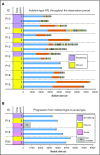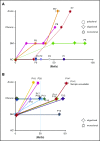Clonality of HTLV-1-infected T cells as a risk indicator for development and progression of adult T-cell leukemia
- PMID: 29296760
- PMCID: PMC5728319
- DOI: 10.1182/bloodadvances.2017005900
Clonality of HTLV-1-infected T cells as a risk indicator for development and progression of adult T-cell leukemia
Abstract
Adult T-cell leukemia (ATL) is an aggressive T-cell malignancy caused by human T-cell leukemia virus type 1 (HTLV-1) that develops along a carcinogenic process involving 5 or more genetic events in infected cells. The lifetime incidence of ATL among HTLV-1-infected individuals is approximately 5%. Although epidemiologic studies have revealed risk factors for ATL, the molecular mechanisms that determine the fates of carriers remain unclear. A better understanding of clonal composition and related longitudinal dynamics would clarify the process of ATL leukemogenesis and provide insights into the mechanisms underlying the proliferation of a malignant clone. Genomic DNA samples and clinical information were obtained from individuals enrolled in the Joint Study for Predisposing Factors for ATL Development, a Japanese prospective cohort study. Forty-seven longitudinal samples from 20 individuals (9 asymptomatic carriers and 11 patients with ATL at enrollment) were subjected to a clonality analysis. A method based on next-generation sequencing was used to characterize clones on the basis of integration sites. Relationships were analyzed among clonal patterns, clone sizes, and clinical status, including ATL onset and progression. Among carriers, those exhibiting an oligoclonal or monoclonal pattern with largely expanded clones subsequently progressed to ATL. All indolent patients who progressed to acute-type ATL exhibited monoclonal expansion. In both situations, the major expanded clone after progression was derived from the largest pre-existing clone. This study has provided the first detailed information regarding the dynamics of HTLV-1-infected T-cell clones and collectively suggests that the clonality of HTLV-1-infected cells could be a useful predictive marker of ATL onset and progression.
Conflict of interest statement
Conflict-of-interest disclosure: The authors declare no competing financial interests
Figures





References
LinkOut - more resources
Full Text Sources
Other Literature Sources

